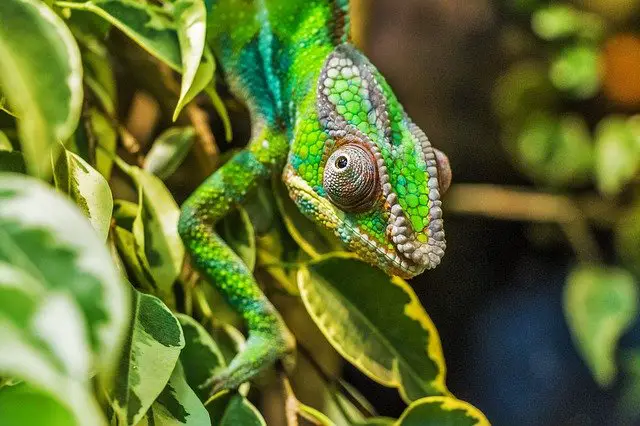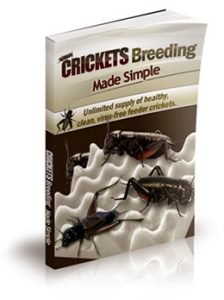Baby chameleons are very fragile animals and as such, require careful care and a lot of special attention. They may need a lot more work than their adult counterparts but the reward is definitely worth investing the extra time.
Introduction to How To Care For A Baby Chameleon
One of the cutest baby animals has got to be the baby chameleon and this incredibly sweet appearance makes them one of the most sought after reptiles on the planets when it comes to keeping a pet. However, whilst they may be beautiful creatures, it is also important to keep in mind that they do require detailed care and should not be taken on by anyone who does not have the time to dedicate to their infant pet.
In this article, we are going to be looking at what is involved in taking care of a baby chameleon, telling you everything you will need to know to make sure your pet has everything they need to thrive.
What Do You Need To Take Care Of A Baby Chameleon?
Whether you have adopted a baby chameleon from someone else or your female has had babies and you have decided to keep one, it is vital that you are prepared and have the correct equipment.
Enclosure
One of the first things that you will need to think about is where your baby chameleon is going to live and this is quite a contentious issue between reptile owners. Some people would swear by using a smaller cage, whereas others would argue that a bigger cage is more suitable. Let’s look at the pros and cons of each.
- If you use a small enclosure for your baby chameleon, it will be much easier to find him. These babies are known for their ability to hide and in a larger cage, this could make them difficult to spot. Of course, you will need to be able to find them to care for them and ensure that they are OK. Furthermore, smaller cages will make it a lot easier to maintain the right humidity levels and temperature.
- In contrast, a larger enclosure will give your baby chameleon lots of spaces to hide and explore and this will likely make her feel safe. Yes, it may be more difficult to locate your pet, at least until she gets bigger but this is fun for some owners. Furthermore, using a larger cage from the get-go means that you won’t need to fork out for another at a later date.
The type of cage that you use is down to you and there is no right or wrong, making this one of the easier decisions when keeping a baby chameleon.
Lighting
Much like any other type of reptile, you will need to install the correct lighting for your baby chameleon. They will need two types of light:
- A UVB light will aid digestion and absorbing calcium.
- A heat lamp to maintain the correct temperature in the enclosure.
The temperature of your baby chameleon’s home should be between 26º and 32ºc and it is important to maintain this as while they are young, the babies may not be able to regulate their body heat as well as an adult.
You should place the light at the top of the cage pointing at somewhere that the chameleon can bask. The basking location will need to be around eight to ten inches away from the light.
Where the UVB light is concerned, this will need to be a 5.0 strip light that runs the length of the top of the enclosure. It should also have a reflector and you will need to make sure that it is changed at least every nine months, with every six months being preferable.
Plants And Foliage
Chameleons are tree-dwelling reptiles so it stands to reason that you will need to fill your pet’s cage with plenty of plants and places to hideout and climb. This is the best way to mimic their natural habitat.
You can use full-sized plants for the babies because even though they are very small, they will still be adept climbers who won’t have an issue tackling larger plants. However, it is important to be sure that these plants are safe for chameleon use. In the main, you should avoid putting any of the following plants into your chameleon’s enclosure:
- Pothos
- Ficus Benjamina
- Schefflera
- Croton
- Philodendron
All of these are toxic to chameleons but unknowingly, they may still ingest them and this can cause serious health problems or even death.
Diet And Water
One of the most essential factors to consider for your baby chameleon is what he will eat and it is vital that you provide a healthy and balanced diet to help him grow and thrive. These animals have a diet that mainly consists of insects in the wild so it is important to try to replicate this as best as possible when keeping them in captivity.
Many pet owners will offer their baby chameleon crickets and locusts, primarily because these are the easiest to come by. They are frequently sold in pet stores across the world and it is perfectly possible to breed your own. However, there are other insects that you can include in the baby chameleon’s diet such as flies, butter worms, wax worms, and cockroaches.
Adult chameleons will also eat fruits but while they are still young, it is a good idea to keep their diet purely made up of insects as this will give them all of the nutrition that they need. Furthermore, you should make sure that the insects you offer are not too large. As a general rule, most people will feed their chameleons food that is no larger than the space between their eyes. For this reason, when feeding a baby, you would need to offer insects that have not yet reached adulthood.
It is crucial that you only supply your pet with food from a pet store or reputable breeder. You must never collect food from the wild as these insects could have ingested pesticides or harmful bacteria that could be detrimental to the health of your pet. In addition to this, insects that are bred for pets will have been gut-loaded and will therefore be far more nutritious.
You will need to give your baby chameleon between ten and twelve insects a day up until they are around half a year old. You can then reduce this slightly. But it is best if you can do this in two sittings rather than just once each day. It is also important to look at how you offer food and in the main, there are three options:
- The cup method requires you to fill a cup with insects and coat them with a calcium powder. You can then place this in the enclosure at a point lower than the animal so that they can shoot their tongue down and catch the insects.
- The free-range method simply means that you can release the insects into the enclosure and allow the baby chameleon to hunt. This is great for when they are an adult and teaches them early.
- Hand-feeding your baby chameleon is a great way to bond with your pet. You can hold the insect between the thumb and forefinger and allow your pet to take it from you.
Within their diet, you can also provide multivitamin and calcium supplements which are essential in keeping your pet healthy. Multivitamins help with general health including the eyes whereas calcium will prevent the chameleon from developing a metabolic bone disease which is common in reptiles who do not receive enough calcium. If this is not done, it can cause your pet a lot of pain and will eventually cause them to pass away.
In terms of water, chameleons do not drink water from a container or bowl-like other pets but will usually take their hydration from moisture in the plants. In the wild, they normally do this in the morning when there is a lot of dew on the leaves. You can mimic this in captivity by spraying the enclosure, however, you must be sure not to spray the water directly onto your pet. Doing this could cause water to enter into the nose and cause the baby to drown.
[su_box title=” Caring for Your Chameleon”]We hope we have answered your question fully today. Our aim of this website is to help people like you take care of your pet chameleon as this is our passion. With that in mind, we invite you to have a look at our concise and complete guide to taking care of Chameleons. It is being used by thousands of our customers and is an absolute must. Just Click Here to have a look and get immediate access now.[/su_box]
Conclusion
Keeping a baby chameleon is relatively hard work but the rewards are certainly worth it. As your pet gets older the intricate care won’t be quite as demanding but you will undoubtedly feel a huge sense of achievement having raised this beautiful baby yourself. This will form a bond for life.





